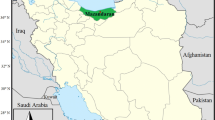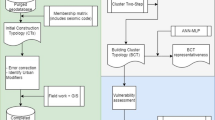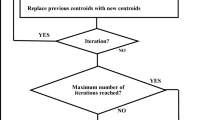Abstract
Several major earthquakes have jolted Pakistan during the last 30 years, destroyed infrastructure and severe damage to the economy. Despite advancement in data sciences and its linkages with other domains, no such study has been conducted in Pakistan, which incorporates the application of machine learning techniques on ambient noise data. This study presents the application of machine learning techniques on the ambient noise data to establish the micro-zones within the urban settlements of northern Potwar region of Pakistan, based on the site response parameters and seismic vulnerability. The ambient noise data from 148 sites in the study area, are acquired, processed and interpreted. Different clustering techniques namely, K-mean, fuzzy c-means and hierarchical clustering have been applied to the interpreted ambient noise data set. Arc GIS maps of the study area have been developed by making use of the interpretation of the ambient noise data and the resulted clustering solutions. The results showed that the fundamental frequency f0 ranges between 0.5 and 15 Hz, the H/V spectral amplification factor ranges between 0.8 and 5.9; the soft sediment thickness ranges from 1.6 to 316 m, whereas, the soil vulnerability index is observed between 0.1 and 63. These site response parameters indicated that the study area is moderate to highly vulnerable to site amplification, and any seismic event can lead to catastrophe within the study area. The clustering techniques also detected three groups from the interpretation of the ambient noise data set by separating the locations according to their vulnerability due to site amplification. The quality of cluster solutions was evaluated using cluster validity indexes and the results of these techniques were compared. These results present the similarities and dissimilarities among different sites and indicate the sites which are geographically distant but have very similar vulnerability characteristics or vice versa. The Arc GIS tool showed the spatial distribution of site response parameters and three zones were established as zone 1, zone 2 and zone 3 with low, intermediate and high values, respectively. The spatial distribution maps showed that the northeastern and northwestern parts of the study area are more vulnerable to site amplification.














Similar content being viewed by others
References
Aslam B, Naseer F (2020) A statistical analysis of the spatial existence of earthquakes in Balochistan: clusters of seismicity. Environ Earth Sci 79:41
Atkinson GM, Cassidy JF (2000) Integrated use of seismograph and strong-motion data to determine soil amplification: Response of the Fraser River delta to the Duvall and Georgia Strait earthquakes. Bull Seismol Soc Am 90:1028–1040
Bezdec JC (1981) Pattern recognition with fuzzy objective function algorithms. Plenum Press, New York, p 1981
Braganza S, Atkinson GM, Molnar S (2017) Assessment of the spatial variability of site response in Southern Ontario. Seismol Res Lett 88(5):1415–1426
Burbank DW, Tahirkheli RAK (1985) The magnetostratigraphy, fission track dating and stratigraphic evolution of the Peshawar intermontane basin, northern Pakistan. Bull Geol Soc Am 96:539–552
Calinski T, Harabasz J (1974) A dendrite method for cluster analysis. Commun Stat 3(1):1–27
Coimbra R, Rodriguez-Galiano V, Olóriz F, Chica-Olmo M (2014) Regression trees for modeling geochemical data—an application to Late Jurassic carbonates (Ammonitico Rosso). Comput Geosci 73:198–207
Davies DL, Bouldin DW (1979) A cluster separation measure. IEEE Trans Pattern Anal Mach Intell 1(2):224–227
Fatmi AN (1973) Lithostratigraphic units of Kohat-Potwar Province. Indus Basin Pakistan Geol Surv Pakistan-Memoir 10:80
Gupta RK, Agrawal M, Pal SK et al (2019) Site characterization through combined analysis of seismic and electrical resistivity data at a site of Dhanbad, Jharkand. India Environ Earth Sci 78:226
Karpatne A, Ebert-Uphoff I, Ravela S, et al (2018) Machine learning for the geosciences: challenges and opportunities, In: IEEE Transactions on Knowledge and Data Engineering. doi: https://doi.org/10.1109/TKDE.2018.2861006
Khan S, Khan MA (2016) Mapping sediment thickness of the Islamabad City using empirical relationships: implications for seismic hazards assessment. J Earth Syst Sci 125(3):623–644
Khan IA, Naeem M, Hassan SA, Bilal H, Mohsin A, Bodlah I (2012) Trophic relationships between aphids and their primary parasitoids. J Insect Sci 12:78
Kramer SL (1996) Geotechnical earthquake engineering. Prentice Hall Inc, Upper Saddle River, New Jersey, p 653
Lermo J, Chávez-García FJ (1993) Site effects evaluation using spectral ratios with only one station. Bull Seismol Soc Am 83:1574–1594
MacQueen JB (1967)"Some Methods for classification and Analysis of Multivariate Observations. In: Proceedings of 5-th Berkeley Symposium on Mathematical Statistics and Probability. Berkeley, University of California Press, 1:281–297
Nakamura Y (1989) A method for dynamic characteristics estimation of subsurface using microtremor on the ground surface. Railway Tech Res Inst Q Rep 30(1):25–33
Parolai S, Bormann P, Milkereit C (2002) New relationships between Vs thickness of sediments and resonance frequency calculated by the H/V ratio of seismic noise for the Cologene area (Germany). Bull Seismol Soc Am 92(6):2521–2527
Peter JR (1987) Silhouettes: A graphical aid to the interpretation and validation of cluster analysis. J Comput Appl Math 20:53–65
Qadri SMT, Nawaz B, Sajjad SH, Sheikh RA (2015a) Ambient noise H/V spectral ratio in site effects estimation in Fateh Jang area. Pakistan Earthq Sci 28(1):87–95
Qadri SMT, Sajjad SH, Sheikh RA et al (2015b) Ambient noise measurements in Rawalpindi-Islamabad, twin cities of Pakistan: a step towards site response analysis to mitigate impact of natural hazard. Nat Haz 78:1111–1123
Qadri SMT, Islam MA, Shalaby MR et al (2017) Characterizing site response in the Attock Basin, Pakistan, using microtremor measurement analysis. Arab J Geosci 10:267
Qadri SMT, Islam MA, Nawaz B, Rehman K (2018) Utilization of microtremor measurements to evaluate fundamental frequency in urban settlement of Taxila-Pakistan', IET Conference Proceedings, 2018, p. 111; DOI: https://doi.org/10.1049/cp.2018.1608
Rehman K, Qadri SMT, Ali A et al (2016) Analysis of the devastating Kashmir earthquake 2005 aftershocks. Arab J Geosci 9:379
Rokach L, Oded M (2005) Clustering methods. Data mining and knowledge discovery handbook. Springer US: 321–352.
Sajjad SH, Waheed SA, Khan T et al (2014) Natural Hazards and related contents in curriculum of Geography in Pakistan. Asian J Nat Appl Sci 3(2):40–48
SESAME (2004) Guidelines for the implementation of the H/V spectral ratio technique on ambient noise vibrations measurements, processing and interpretation. SESAME Euro Res Project WP 12:1–62
Shah AA, Qadri SMT (2017) Segmentation of Main Boundary Thrust and Main Central Thrust in Western Himalaya for assessment of seismic Hazard by Mridula et al. Nat Hazards (2016) 84:383-403. Nat Hazards 87(2):1245–1249. https://doi.org/10.1007/s11069-017-2794-6
Shah AA, Qadri T, Khwaja S (2018) Living with earthquake hazards in South and Southeast Asia. ASEAN J Commun Engag 2:15–37
Trevisani S, Boaga J (2018) Passive seismic prospecting in Venice historical center for impedance contrast mapping. Environ Earth Sci 77:733
Vahid B, Kadkhodaie A, Farzi R (2017) Analyzing organic richness of source rocks from well log data by using SVM and ANN classifiers: A case study from the Kazhdumi formation, the Persian Gulf basin, offshore Iran. J Petrol Sci Eng 151:224–234
Warnana DD, Ria RAA, Utama W (2011) Application of microtremor HVSR method for assessing site effect in residual soil slope. Int J Basic Appl Sci 11(04):73–78
Yaghmaei-Sabegh S (2017) A novel approach for classification of earthquake ground-motion records. J Seismol 21:885–907. https://doi.org/10.1007/s10950-017-9642-8
Yaghmaei-Sabegh S, Hassani B (2020) Investigation of the relation between Vs30 and site characteristics of Iran based on horizontal-to-vertical-spectral ratios. Soil Dynamics and Earthquake Engineering, 128. Doi: https://doi.org/10.1016/j.soildyn.2019.105899
Yihui X, Zuo R (2016) Recognition of geochemical anomalies using a deep autoencoder network. Comput Geosci 86:75–82
Yongxiang C, Wang X, Hu K, Dong M (2014) A data mining approach to finding relationships between reservoir properties and oil production for CHOPS. Comput Geosci 73:37–47
Zhao X, Hu K, Burns SF et al (2019) Classification and sudden departure mechanism of high-speed landslides caused by the 2008 Wenchuan earthquake. Environ Earth Sci 78:125
Author information
Authors and Affiliations
Corresponding author
Ethics declarations
Conflict of interests
Authors declare no competing interests.
Computer code availability
Ambient noise datasets were acquired processed and interpreted using Scream 4.5 and GEOPSY software which are available online. All the code and data are available at the following link: https://github.com/malikowais/AmbientNoise.
Additional information
Publisher's Note
Springer Nature remains neutral with regard to jurisdictional claims in published maps and institutional affiliations.
Rights and permissions
About this article
Cite this article
Qadri, S.M.T., Malik, O.A. Establishing site response-based micro-zonation by applying machine learning techniques on ambient noise data: a case study from Northern Potwar Region, Pakistan. Environ Earth Sci 80, 53 (2021). https://doi.org/10.1007/s12665-020-09322-7
Received:
Accepted:
Published:
DOI: https://doi.org/10.1007/s12665-020-09322-7




